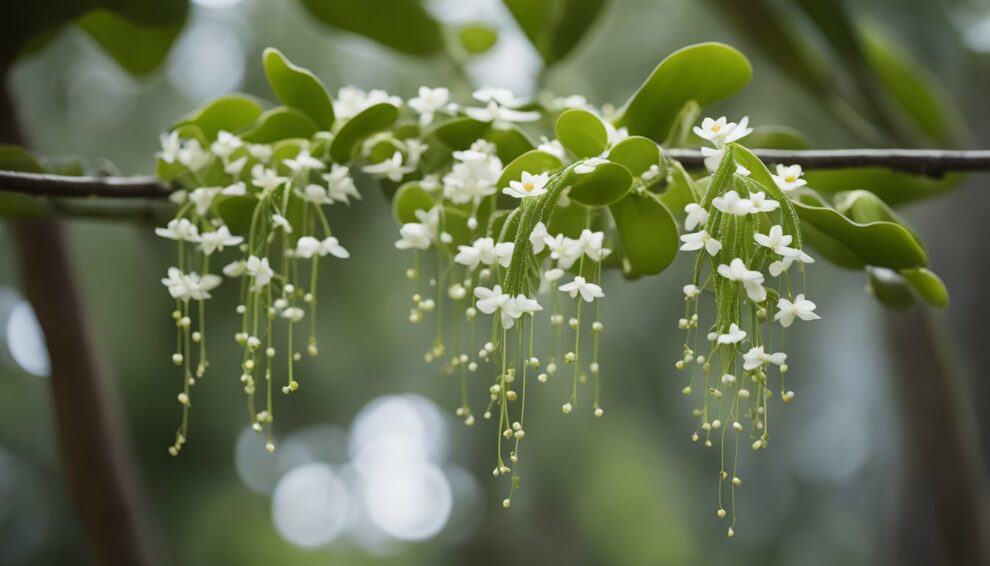The Mistletoe Cactus, also known as Rhipsalis baccifera, is a popular houseplant that is native to the rainforests of Central and South America.
This plant has become increasingly popular in recent years due to its unique appearance and easy care requirements.
However, despite its popularity, many people still struggle to care for their Mistletoe Cactus properly.

In this article, we will explore the mysteries of the Mistletoe Cactus and provide tips on how to care for this plant in urban jungles.
We will cover everything from watering and light requirements to soil and fertilization needs.
Whether you are a seasoned plant enthusiast or a beginner, this article will provide you with the information you need to successfully care for your Rhipsalis baccifera.
So, let’s dive in and unravel the mysteries of the Mistletoe Cactus!
Understanding Rhipsalis Baccifera
Species Overview
Rhipsalis Baccifera, commonly known as Mistletoe Cactus, is a fascinating epiphytic cactus species that belongs to the family Cactaceae.
It is native to the tropical rainforests of Central and South America, where it grows on trees as an epiphyte.
The plant has a unique appearance, with long, thin, and flexible stems that are green or reddish-brown in color.
The stems can grow up to 6 feet long and 0.5 inches in diameter, and they produce small, white flowers that bloom in the spring and summer.
The flowers are followed by small, red or white berries that resemble mistletoe, hence the common name.
Mistletoe Cactus is a popular houseplant due to its unique appearance and easy care requirements.
It is an excellent choice for urban jungles, as it can thrive in low light conditions and does not require much water or maintenance.
With proper care, the plant can live for many years and grow into a beautiful and impressive specimen.
Natural Habitat
Rhipsalis Baccifera is native to the tropical rainforests of Central and South America, where it grows on trees as an epiphyte.
The plant is found in a variety of habitats, including lowland rainforests, cloud forests, and montane forests.
It prefers to grow in areas with high humidity and filtered light, as direct sunlight can damage its delicate stems.
In its natural habitat, Mistletoe Cactus grows on the branches of trees, using its long, thin stems to reach out and capture as much light as possible.
It has adapted to this lifestyle by developing a specialized root system that allows it to absorb moisture and nutrients from the air and rainwater.
The plant also has a symbiotic relationship with ants, which help to protect it from predators and provide it with additional nutrients.
Overall, Rhipsalis Baccifera is a fascinating and unique plant species that is well-suited for urban jungles.
With a little bit of care and attention, it can thrive and add a touch of tropical beauty to any indoor space.
Essential Care Guidelines

Lighting Requirements
Rhipsalis baccifera prefers bright, indirect light, but it can also tolerate low light conditions.
Direct sunlight can scorch the leaves, so it is best to place the plant near a window with sheer curtains or in a shaded area outdoors.
Watering Techniques
The mistletoe cactus is a succulent that stores water in its leaves and stems.
Overwatering can lead to root rot, so it is important to let the soil dry out between waterings.
Water the plant thoroughly, allowing excess water to drain out of the pot. In the winter months, reduce watering to once every two to three weeks.
Temperature and Humidity
Rhipsalis baccifera thrives in temperatures between 60-80°F (15-27°C). It can tolerate lower temperatures, but not below 50°F (10°C).
The mistletoe cactus prefers moderate to high humidity levels, so it is recommended to mist the leaves with water or place a tray of water near the plant to increase humidity.
Overall, Rhipsalis baccifera is a low-maintenance plant that requires minimal care.
By following these essential care guidelines, you can keep your mistletoe cactus healthy and vibrant in your urban jungle.
Propagation and Repotting

Propagation Methods
Rhipsalis baccifera can be propagated through stem cuttings. The best time to take cuttings is during the spring or summer.
The cutting should be about 4-6 inches long and have at least two segments. Remove the lower segments and allow the cutting to dry for a few days.
Then, dip the cutting into rooting hormone and plant it in a well-draining soil mix. Keep the soil moist and place the cutting in a bright, indirect light.
It should root within a few weeks.
Repotting Tips
Rhipsalis baccifera prefers to be slightly root-bound, so repotting should only be done when necessary.
When the plant becomes too large for its current pot, it’s time to repot.
Choose a pot that is only slightly larger than the current one and has drainage holes.
Use a well-draining soil mix and add some sand or perlite to improve drainage. Gently remove the plant from its current pot and loosen any tangled roots.
Place the plant in the new pot and fill in around it with soil.
Water the plant thoroughly and allow it to drain before placing it in a bright, indirect light.
It’s important to avoid overwatering after repotting, as the plant may be in shock and more susceptible to root rot.
Wait a few weeks before fertilizing the plant to allow it to adjust to its new pot and soil.
With proper care and attention, Rhipsalis baccifera can thrive and bring a touch of the jungle to any urban space.
Troubleshooting Common Issues

Pest Prevention
Mistletoe cactus is prone to infestations by pests such as spider mites, mealybugs, and scale insects.
To prevent pest infestations, it’s essential to keep the plant healthy and stress-free.
Here are some tips to prevent pests from attacking your Rhipsalis baccifera:
- Regularly inspect the plant for any signs of pests, such as webbing, sticky residue, or small insects.
- Isolate the plant immediately if you notice any pests to avoid spreading the infestation to other plants.
- Keep the plant in a well-ventilated area with good air circulation to prevent stagnant air that attracts pests.
- Avoid overwatering the plant, as excess moisture can attract pests and lead to root rot.
If you notice any pests on your mistletoe cactus, you can use natural pest control methods such as neem oil or insecticidal soap.
Make sure to follow the instructions carefully and avoid using harsh chemicals that may harm the plant.
Disease Management
Mistletoe cactus is generally disease-resistant, but it can develop fungal or bacterial infections if the plant is stressed or kept in poor conditions.
Here are some tips to prevent and manage common diseases in Rhipsalis baccifera:
- Avoid overwatering the plant, as excess moisture can lead to root rot and fungal infections.
- Ensure the plant has adequate drainage to prevent water from accumulating in the soil.
- Keep the plant in a well-ventilated area with good air circulation to prevent stagnant air that can lead to fungal infections.
- Avoid exposing the plant to extreme temperatures or sudden changes in temperature, as this can stress the plant and make it more susceptible to diseases.
If you notice any signs of disease, such as yellowing leaves, wilting, or fungal growth, isolate the plant immediately to prevent spreading the infection to other plants.
You can use natural fungicides or bactericides to treat the plant, but make sure to follow the instructions carefully and avoid using harsh chemicals that may harm the plant.
Frequently Asked Questions

How often should I water my Rhipsalis baccifera to keep it thriving?
Rhipsalis baccifera is a low-maintenance plant and does not require frequent watering.
It is recommended to water it once a week during the growing season, and reduce watering during the winter months.
Make sure the soil is dry before watering again to prevent overwatering, which can lead to root rot.
What’s the ideal lighting setup for a Mistletoe Cactus in an apartment setting?
Mistletoe cactus prefers bright, indirect light. It can tolerate some direct sunlight, but too much can cause sunburn.
Place the plant near a window that receives filtered light or use a sheer curtain to diffuse the light.
In low-light conditions, the plant may not grow as well and may become leggy.
Can you share some tips for propagating a Mistletoe Cactus?
Propagation of Rhipsalis baccifera is easy and can be done using stem cuttings.
Take a stem cutting that is at least 4 inches long and remove the lower leaves.
Allow the cutting to dry for a few days, then plant it in a well-draining soil mix.
Keep the soil moist and place the cutting in a bright, indirect light location. The cutting should root in a few weeks.
What are the common pests to look out for on Rhipsalis baccifera, and how can I treat them?
Mistletoe cactus is generally pest-free, but it can occasionally be affected by mealybugs or scale insects.
These pests can be treated by wiping the leaves with a cotton swab dipped in rubbing alcohol.
If the infestation is severe, use an insecticidal soap or neem oil to treat the plant.
How do I know if my Mistletoe Cactus needs repotting, and what’s the best soil mix to use?
Rhipsalis baccifera prefers to be root-bound, so repotting is not necessary very often.
However, if the plant has outgrown its container or the soil is compacted, it may need to be repotted.
Signs that the plant needs repotting include roots growing out of the drainage holes or the soil drying out quickly after watering.
Use a well-draining soil mix that contains peat moss, perlite, and sand.
Is the Rhipsalis baccifera pet-friendly, or should I keep it away from my furry friends?
Mistletoe cactus is non-toxic to pets and is safe to keep around cats and dogs.
However, it is still recommended to keep the plant out of reach to prevent accidental ingestion, which can cause stomach upset.














